The Print Collection
MOEBIUS - Major Grubert - Garage Hermétique

Artist
Title
Year
Technique
Size
Edition
Signed
Publisher
Moebius
Major Grubert
1995
Offset lithography
40x50 cm
Epreuve d'Artiste XXXV/L
Yes
Edition Kunst Der Comics -
Nürnberg
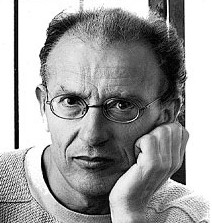
Moebius (Jean Giraud)
1938 - 2012
Jean Giraud has been described as the most influential bandes dessinées artist after Hergé. His most famous works include the series Blueberry, featuring one of the first anti-heroes in Western comics. As Moebius he created a wide range of science fiction and fantasy comics in a highly imaginative and surreal style. These works include 'Le Garage Hermetique', 'Arzach' and the comic book series 'The Incal' (in collaboration with avant-garde filmmaker Alejandro Jodorowsky). Moebius also contributed storyboards and concept designs to numerous science fiction and fantasy films, such as Alien, Tron, The Fifth Element and The Abyss.
This print is an artist proof from the printing process of Edition Kunst Der Comics' portfolio 'Comic Künstler Galerie nr 3'. The print depicts the front cover of both the 1980 album 'Le Garage Hermetique' and the 1976 cover of issue no.6 of 'Métal Hurlant', the magazine where the story was initially serialised in two-to-four-page episodes.
Moebius has explained that 'Le Garage Hermetique' was improvised in a deliberately whimsical or capricious manner. For this reason, the story is at times (deliberately) confusing. The "garage" itself is actually an asteroid in the constellation Leo which houses a pocket universe. Major Grubert orbits the asteroid in his spaceship Ciguri, from which he oversees the development of the worlds contained within.
MOEBIUS - Le Vaisseau Volant
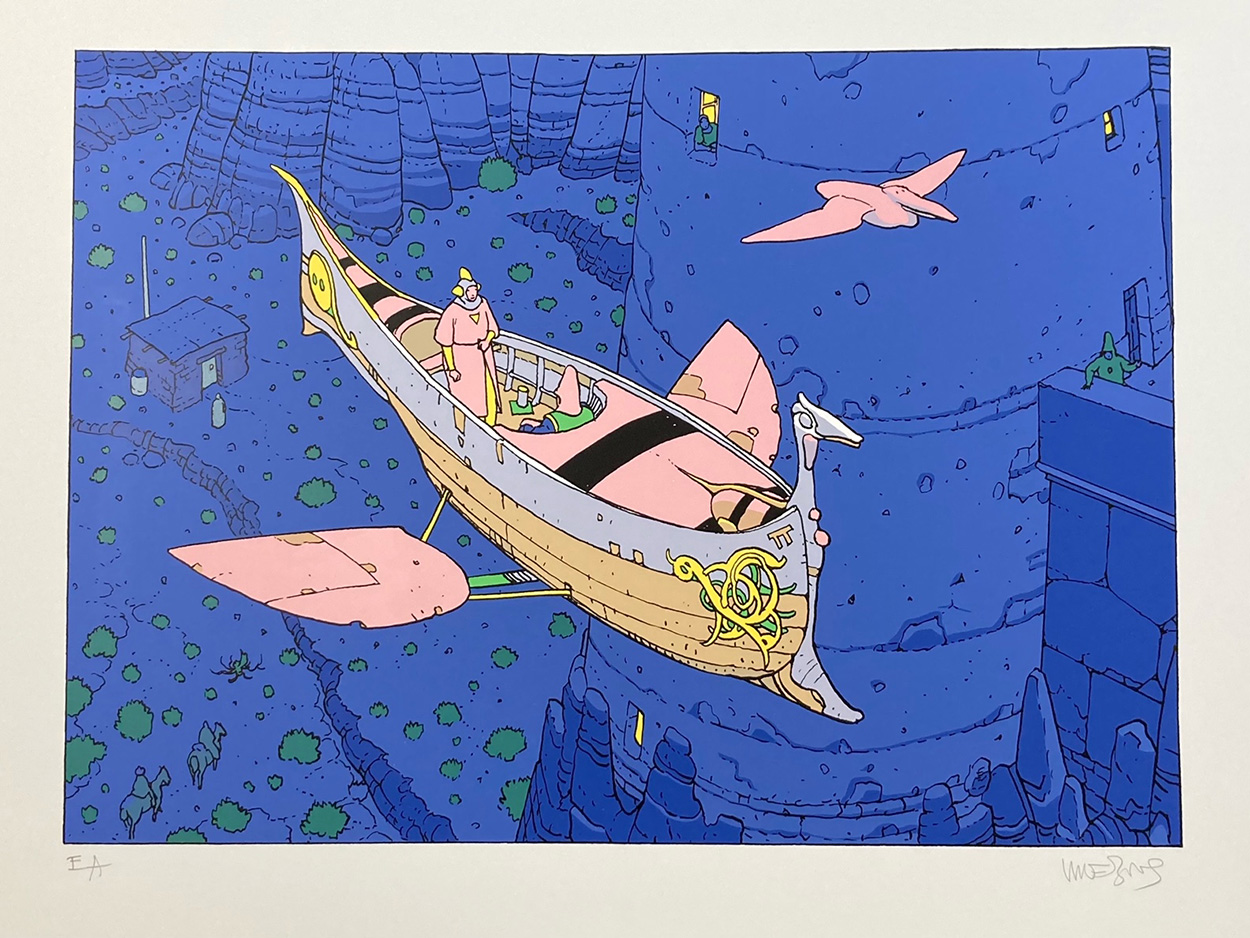
Artist
Title
Year
Technique
Size
Edition
Signed
Publisher
Moebius
Le Vaisseau Volant
1995
Silkscreen print
63x50 cm
Epreuve d'Artiste
Yes
Private commision

Moebius (Jean Giraud)
1938 - 2012
Jean Giraud, popularly known as Moebius, was a French artist and cartoonist revered for colorful, outlandish, and surreal science fiction and fantasy comics, as well as his work as a film concept designer. Giraud began using the Moebius pseudonym in 1963 specifically for his fantasy and science fiction works. The style and tone of his artwork is very adaptive and through the course of his career has generally shifted from more realistic, as seen in his early Blueberry series, to more expressive and fantastical compositions.
This print is one of ten unnumbered artist proofs from a commisioned limited edition of 400 copies.
The print depicts a scene from the Arzach universe;
A flying vessel accompanied by a pelican/pterodactyl-like bird floats by a populated tower in a mountainous landscape. The overwhelming sense of calm present on the vessel is contrasted by the excitement of the watchers from the tower below. Due to the satin quality finish of the paper, the layers of ink presents an unusual richness. Overlapping layers additionally creates deeper hues.
BILAL - La Femme piège
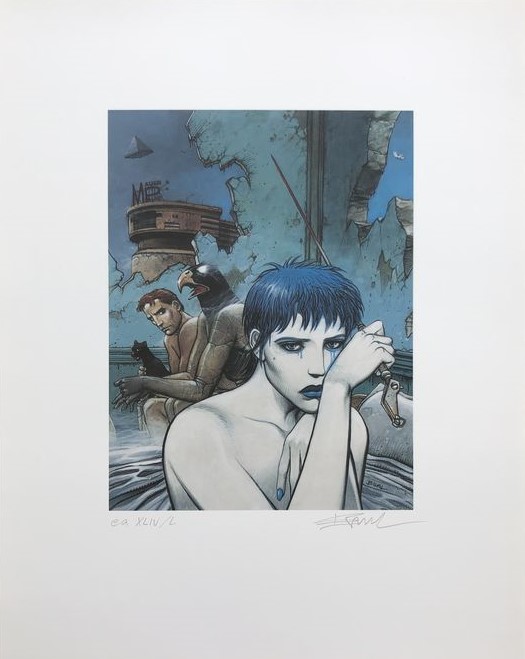
Artist
Title
Year
Technique
Size
Edition
Signed
Publisher
Enki Bilal
La Femme piège
1988
Offset lithography
40x50 cm
22/350
Yes
Edition Kunst Der Comics -
Nürnberg
Enki Bilal
1951 -

Born in Belgrade where his father was Josip Tito's tailor. Moved to Paris at the age of 9. Together with script writer Pierre Christin, he created several comics, including 'Les Phalanges de l'Ordre Noir' and 'Partie de Chasse'. He is best known for his solo effort; the Nikopol trilogy (La Foire aux immortels, La Femme piège and Froid Équateur). Besides his comics activities, Enki Bilal also works in film, theater and opera, photo retouching and glass painting An asteroid was named after him in 2006.
This print is taken from the Edition Kunst Der Comics' portfolio 'Comic Künstler Galerie nr 1'. The print depicts the front cover of the 1986 album 'La Femme Piège' - the second instalment of the Nikopol trilogy
The image shows journalist and protagonist Jill Bioskop armed with her deadly scripwalker antenna. In the background Egyptian god Horus, mental asylum escapee Alcide Nikopol and telepathic cat Gogol d'Algol. In the far background the pyramid-shaped spaceship of the Egyptian gods hovers over Berlin's hotel Mauer Palast.
BILAL - La Foire aux immortels
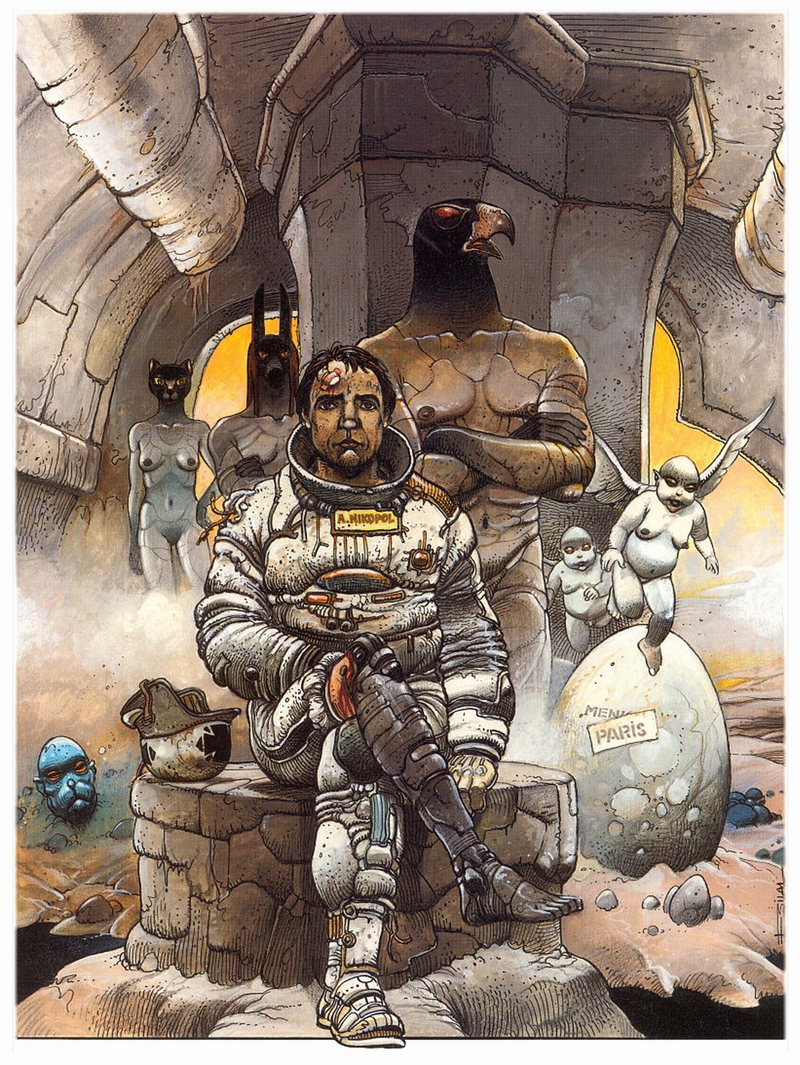
Artist
Title
Year
Technique
Size
Edition
Signed
Enki Bilal
La Foire aux immortels
Early 1980es
Offset print
20x29 cm
277/500
Yes
Enki Bilal
1951 -

Enki Bilal is French-Yugoslavian comic book writer and artist, best known for his Nikopol Trilogy. He also wrote and drew the 'Le Sommeil du monstre' quartet. Working primarily as a graphic artist and illustrator, Bilal has also directed three movies, Bunker Palace Hotel (1989), Tykho Moon (1997), and Immortal (2004).
This print is a limited edition print of unknown origin. The print depicts the front cover of the 1980 album 'La Foire aux immortels' - the first instalment of the Nikopol trilogy
The image shows Parisian metro station Alesia in a 1980 take on 2023. In the foreground; the reluctant protagonist Alcide Nikopol having recently returned to Earth after a hardware malfunction has kept him frozen in space for 30 years. Behind him the paranoid Egyptian god Horus who is about to take possesion of Nikopol's body in order to achieve his own megalomanic agenda.
TARDI - Adèle et la Bête
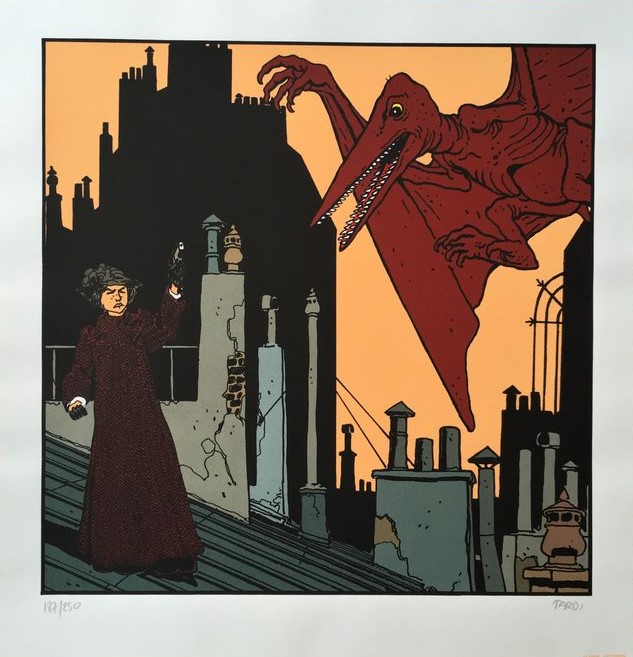
Artist
Title
Year
Technique
Colour
Size
Edition
Signed
Paper
Publisher
Jacques Tardi
Adèle et la Bête
1996
Silkscreen print
8 passages
65x63 cm
153/250
Yes
Vélin Cuve bfk Rives 250 g
Champaka - Bruxelles

Jacques Tardi
1946 -
Jacques Tardi is one of the most important and influential French comics artists. Recurring themes in his works are World War I, detective stories and the underworld of the city. His signature series 'Les Extraordinaires Aventures d'Adèle Blanc-Sec' recreates Paris of early the 20th century where the moody heroine encounters supernatural events, state plots, occult societies and experiments in cryogenics.
This is the introductory print of Brussels based gallery and art publisher Champaka's series of four silkscreen prints of the cover illustrations of Tardi's Adèle Blanc-Sec albums. The “Adèle et la bête” silkscreen print was issued on October 1st 1996, and depicts the front cover of the 1976 album 'Adèle et la Bête'. It shows Adèle, the eponymous heroine, and the pterodactyl (hatched from a prehistoric egg at the National History Museum at Jardin des Plantes by paranormal means by scientist Boutardieu) on the rooftops of Paris.
TARDI - Le démon de la Tour Eiffel
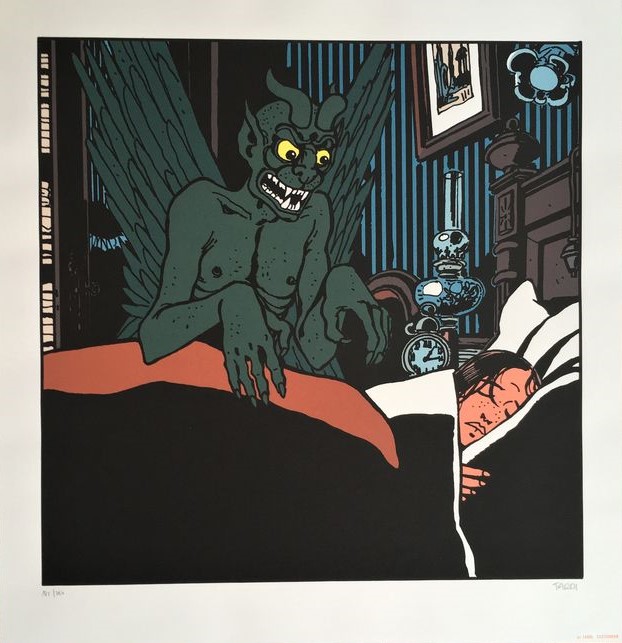
Artist
Title
Year
Technique
Colour
Size
Edition
Signed
Paper
Publisher
Jacques Tardi
Le démon de la Tour Eiffel
1997
Silkscreen print
8 passages
65x63 cm
235/250
Yes
Vélin Cuve bfk Rives 250 g
Champaka - Bruxelles

Jacques Tardi
1946 -
What, for Jacques Tardi, is the essence of a “good” cover illustration? “It has to be a reflection of the book” he says. “I’ve always been annoyed by covers that bear no relation to the content of the book. The covers of “Blueberry” bother me. It’s nothing to do with their graphic properties. They resemble film posters. I like to see, on an album cover, the same graphic style that is found in the book itself. For that reason, the Tintin covers are excellent.”
This is the second print of Brussels based gallery and art publisher Champaka's series of four silkscreen prints of the cover illustrations of Tardi's Adèle Blanc-Sec albums. The “Le démon de la Tour Eiffel” silkscreen print was issued on April 1st 1997, and depicts the front cover of the 1976 album 'Le démon de la Tour Eiffel'.
The print shows Adèle asleep in her bed, with the Mesopotamian demon Pazuzu stooping over her. The demon is either a bad dream or reknowned actress and Pazuzu cult worshipper Clara Benhardt in disguise.
TARDI - Le Savant Fou
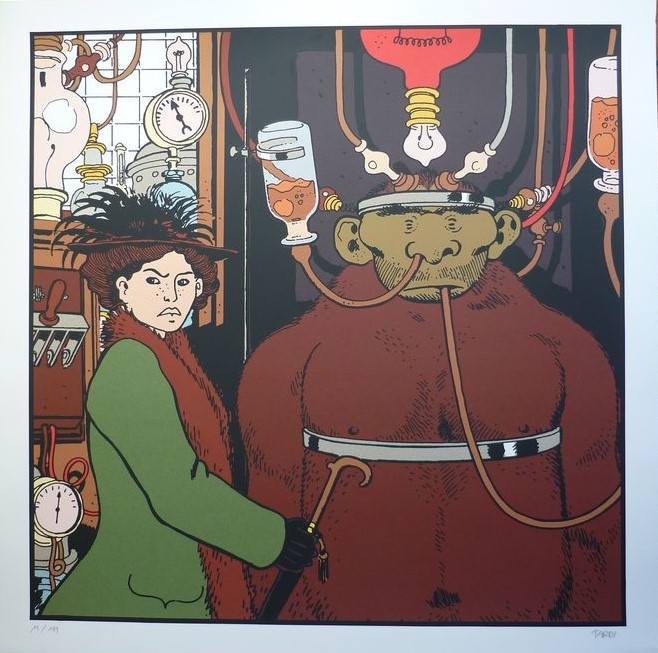
Artist
Title
Year
Technique
Colour
Size
Edition
Signed
Paper
Publisher
Jacques Tardi
Le Savant Fou
1998
Silkscreen print
8 passages
60x60 cm
157/250
Yes
Vélin Cuve bfk Rives 250 g
Champaka - Bruxelles

Jacques Tardi
1946 -
Tardi describes his album covers as “quite static”: “I’m not an artist of the moving image; my characters tend to be fixed, and I create a kind of freeze-frame…though this is not cinema! Coming across the cover of "La Marque Jaune" in the window of a bookshop in my neighbourhood was a real jolt for me. I looked, at length, at these two characters who seemed to return my gaze, and at that strange yellow sign behind them. This cover admirably achieved its purpose, namely, to attract the eye through fascination, rather than through some gaudy device in the way that advertising does.”
This is the third print of Brussels based gallery and art publisher Champaka's series of four silkscreen prints of the cover illustrations of Tardi's Adèle Blanc-Sec albums. The “Le Savant Fou” silkscreen print was issued on September 1st 1998, and depicts the front cover of the 1977 album 'Le Savant Fou'.
The print shows Adèle in the laboratory of mad scientist Espérandieu. Next to her the prehistoric Pithecantropus recovered from the Siberian permafrost, and brought back to life, as part of Esperandieu's grand plan of creating an army of prehistoric apemen to win back the lost provinces of Alsace Lorraine.
TARDI - Dans la Gare
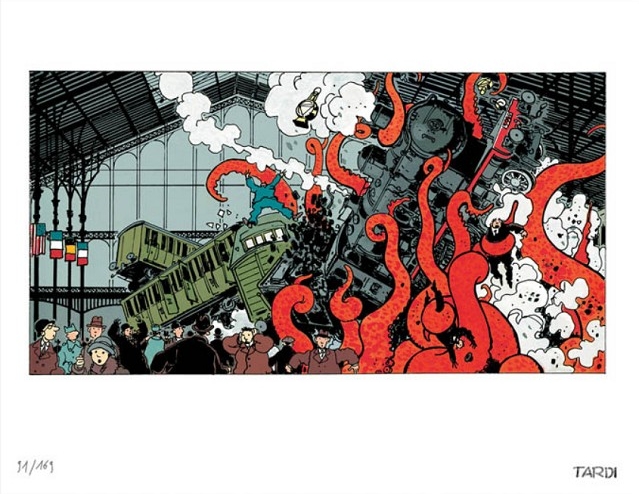
Artist
Title
Year
Technique
Size
Edition
Signed
Publisher
Jacques Tardi
Dans la Gare
2010
Offset lithography
40x50 cm
16/169
Yes
Galerie Arludik - Paris

Jacques Tardi
1946 -
Tardi's 'Les Aventures extraordinaires d'Adèle Blanc-Sec' comic book series first appeared in 1976 published in album format by Belgian publisher Casterman. The adventures, set in Paris in the years before and after World War I, revolve around the protagonist Adèle Blanc-Sec. Themes of the occult, corruption, official incompetence, and the dangers of patriotism suffuse the series. One of Tardi's most popular works and his first to span multiple albums, it has been reprinted in English and other translations and has been adapted as a feature film by Luc Besson.
This is a limited edition print issued by Paris based Galerie Arludik. The “Dans la Gare” print was issued in April 2010, and depicts a frame from page 39 of the 1985 Adèle Blanc-Sec album 'Le Noyé à deux têtes'.
The print shows the sudden appearance of several giant tentacles derailing the 17:50 express train at Gare du Nord on November 11th 1918. The tentacles are the materialisation of Verdun survivor Honoré Fia's subconcious anxiety, exploited and amplified by mad scientist Dieuleveult who seeks to utilise Fia's metapsychic abilities to his own devious means.
FRANQUIN - Le Marsupilami - Café du Pont
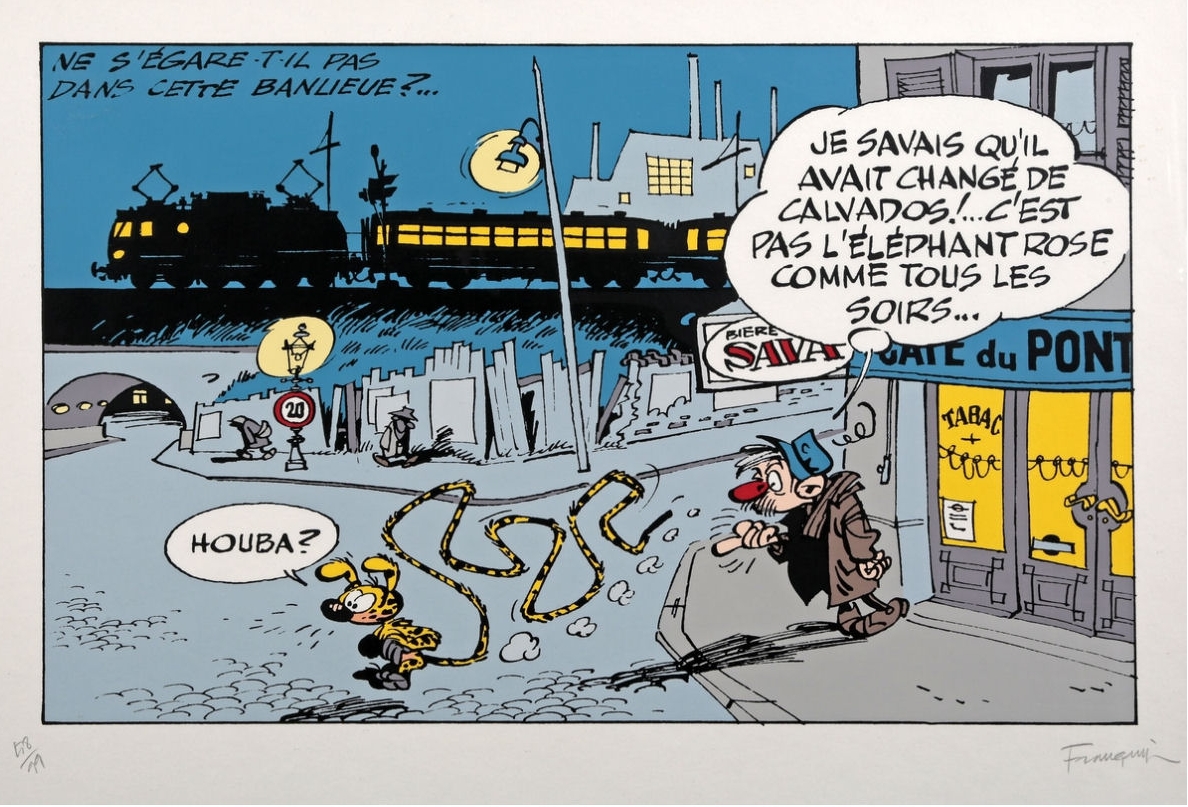
Artist
Title
Year
Technique
Size
Edition
Signed
Paper
Publisher
André Franquin
Le Marsupilami - Café du Pont
1987
Silkscreen print
50x70 cm
34/99
Yes
Steinbach
Editions Breydel - Bruxelles
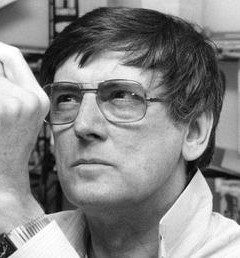
André Franquin
1924 - 1997
Franquin is widely considered one of the major artists of European comics. A leading contributor to Spirou magazine, he was the third official author of the title comic, 'Spirou et Fantasio'. Between 1946 and 1969, Franquin enriched the series with longer and more intricate narratives. He introduced many colorful secondary characters, such as the inhabitants of the town of Champignac, the recurring villains Zorglub and Zantafio, and the world's strangest animal, the Marsupilami. Most of his creations remained part of the 'Spirou' universe after Franquin's run, with the exception of the long-tailed Marsupilami, who since 1987 has starred in his own spin-off series. Franquin is best known for the aforementioned Marsupilami, plus his signature series 'Gaston Lagaffe' (1957-1996), about a lazy and incompetent office clerk.
This is a limited edition print taken from the Editions Breydel' portfolio 'Le Nid du Marsupilami'. The print depicts a frame from page 31 of the 1966 album 'QRN sur Bretzelburg': The Marsupilami has fled hospital (after nose surgery to remove a mini transitor radio that he's ingested), to search for his friend Fantasio who's been abducted by the secret Bretzelpolizei of the dictatorial state of Bretzelburg.
Running parallel with the main story, the Marsupilami's trek across Europe fascilitates several gags like the one depicted in the print.
Franquin has explained that he started 'QRN sur Bretzelburg' intending it to be another Zorglub story, but that this was vetoed by publisher Dupuis. Half-way through Franquin was forced by an early bout of depression to abandon the story and return to it later. Franquin realised at that time that he would not carry on with Spirou et Fantasio for much longer.
FRANQUIN - Les Idées Noires - Les Mouettes

Artist
Title
Year
Technique
Size
Edition
Signed
Publisher
André Franquin
Les Idées Noires - Les Mouettes
1989
Silkscreen print
40x50 cm
Hors Commerce 15/100
Yes
Edition Kunst Der Comics - Nürnberg

André Franquin
1924 - 1997
Franquin was an influential Belgian comics artist, who produced the Spirou et Fantasio comic strip from 1946 to 1969, a period seen by many as the series' golden age. Along with artists such as Morris and Peyo, Franquin was a pioneer of the "Marcinelle school" ; a drawing style named after the Belgian town where the office of the influential 'Spirou' magazine was located. The style soon became the preferred in-house style for the magazine, and thus had a huge impact on the Franco-Belgian comics scene, inspiring generations of cartoonists. Stylistically, the Marcinelle school is a mix of cartoon and realism, and is also sometimes called comic-dynamic. It is often cited in opposition to Hergé's ligne claire style. Though these two styles have much in common, Marcinelle school is all about conveying the impression of movement, while ligne claire tends to be more schematic.
This is a Hors Commerce print taken from the Edition Kunst Der Comics' portfolio 'Comic Künstler Galerie nr 2'. The print depicts a full page from the 1981 album 'Idées Noires'
'Idées Noires' came about as an outlet for Franquin's ongoing spells of depression. The gags often take their inspiration from real-life fears, like horrific accidents, executions, suicides, being eaten by animals, epidemics, world war, the atomic bomb and mankind eventually destroying itself. The nihilistic tone is complimented by the black-and-white ink drawings which all feature silhouetted characters cast in shadowy backgrounds. Franquin eventually quit the series because it became all too depressing.
HUGO PRATT - Tango 1
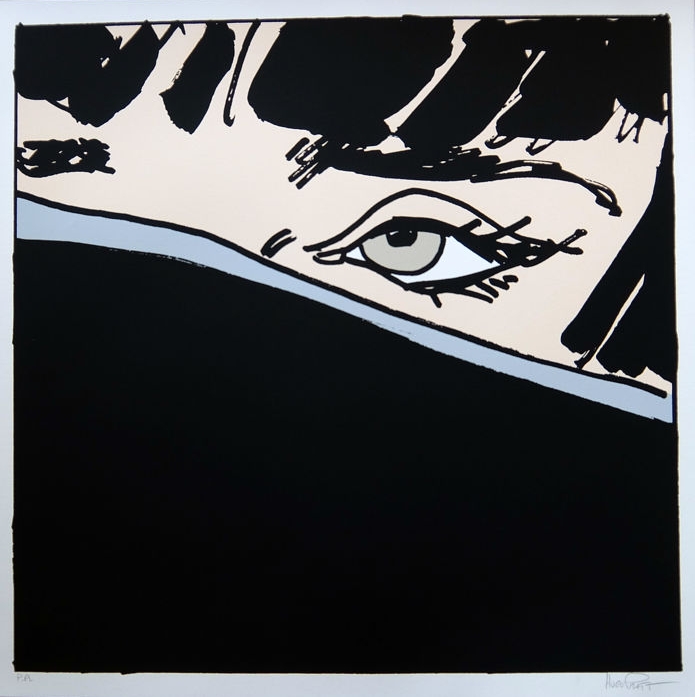
Artist
Title
Year
Technique
Size
Edition
Signed
Publisher
Hugo Pratt
Tango 1
1986
Silkscreen print
70x70 cm
Prova d'Artista
Yes
Editori del Grifo - Rome
Hugo Pratt
1927 - 1995
Hugo Pratt was an Italian comic book artist and creator of 'Corto Maltese; Pratt's signature series about an adventurous sailor around the turn of the 19th/20th century. Pratt was known for combining strong storytelling with extensive historical research.
This print is an Artist Proof from the printing process of Editori del Grifo's 'Tango' portfolio. The 'Tango' portfolio consist of 12 individual prints each depicting a frame from the opening page of the Corto Maltese album 'Tango'
HUGO PRATT - Tango 9
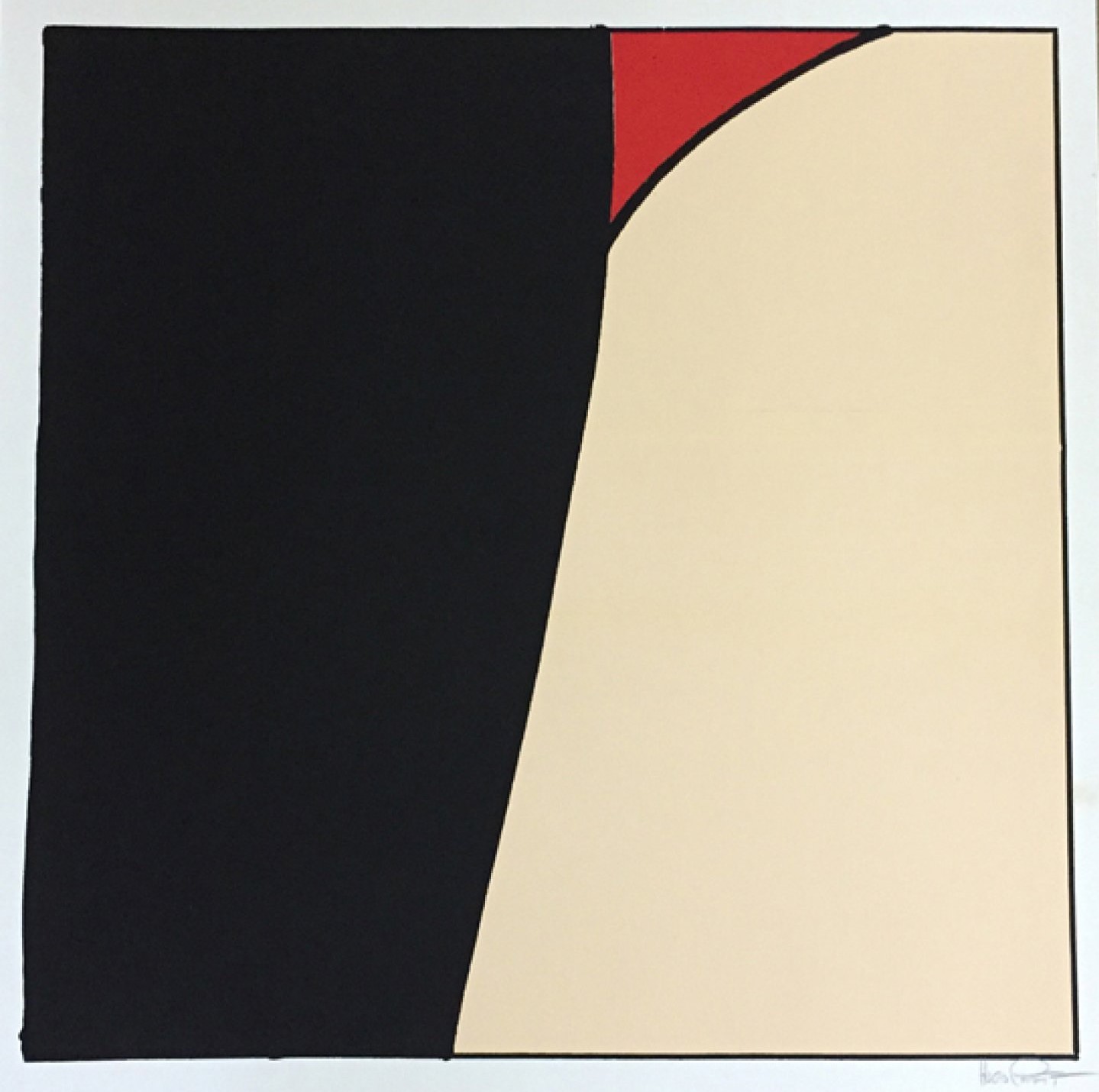
Artist
Title
Year
Technique
Size
Edition
Signed
Publisher
Hugo Pratt
Tango 9
1986
Silkscreen print
70x70 cm
Prova d'Artista
Yes
Editori del Grifo - Rome
Hugo Pratt
1927 - 1995
Hugo Pratt was an Italian comic book artist and creator of 'Corto Maltese; Pratt's signature series about an adventurous sailor around the turn of the 19th/20th century. Pratt was known for combining strong storytelling with extensive historical research.
This print is an Artist Proof from the printing process of Editori del Grifo's 'Tango' portfolio. The 'Tango' portfolio consist of 12 individual prints each depicting a frame from the opening page of the Corto Maltese album 'Tango'
LOUSTAL - Prés du Soudan
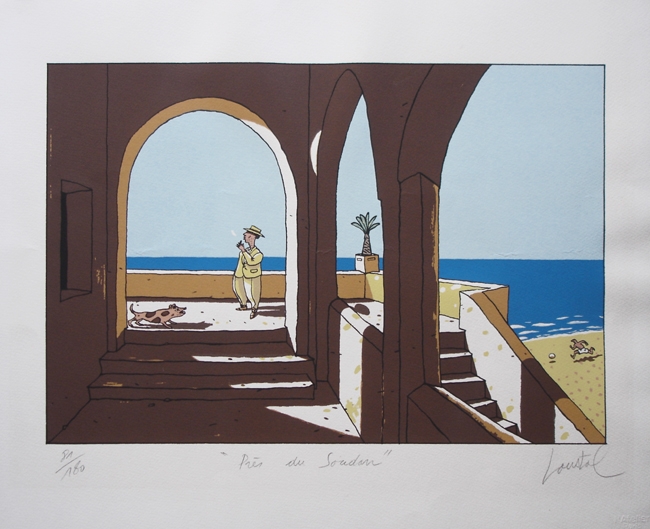
Artist
Title
Year
Technique
Size
Edition
Signed
Paper
Publisher
Jacques de Loustal
Prés du Soudan
1984
Silkscreen print
65x55 cm
38/180
Yes
BFK Rives
Carton Éditions, Lyon
Jacques de Loustal
1956 -
Jacques de Loustal is a French comics artist who uses a painterly style reminiscent of David Hockney. In combination with a career as an illustrator, Loustal began working in comics in the late 70s publishing short comics in the Franco-Belgian comics magazine Métal Hurlant. Independent albums include 'Coeurs de Sable', 'Barney et la Note Bleue' and 'Kid Congo'. Since 2008 Loustal has been a frequent cover illustrator for the American weekly magasine 'The New Yorker'.
This is a limited edition print published by Carton Éditions, Lyon, but printed by L'Atelier in Paris.
Despite the title the 'Pres du Soudan' print is actually based on a travel scetch from the Oudah delta in Morocco.
Loustal: "The Californian blue is definitely inspired by Hockney whereas the estranged figure on the terrace is a reference to Hopper.”
”I prefer instinctive and figurative painters. The painters of the beginning of the century Matisse, Modigliani, Gauguin. All the German painters of "the new subjectivity", Beckmann, Grosz, Otto Dix. And of course, Hopper, Hockney, Balthus, for the immobility."
LOUSTAL - Une party chez l'Arumbaya
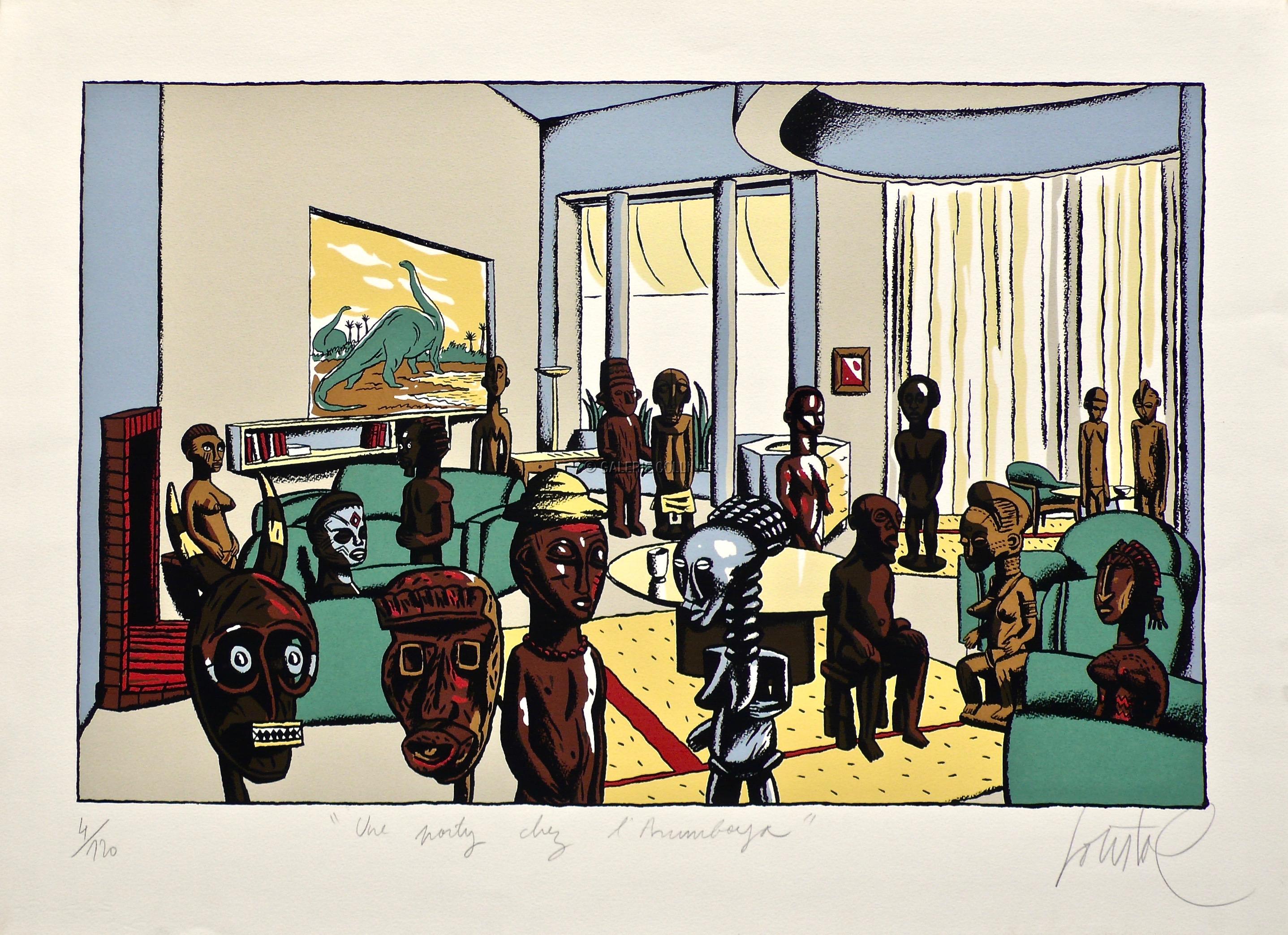
Artist
Title
Year
Technique
Size
Edition
Signed
Paper
Publisher
Jacques de Loustal
Une party chez l'Arumbaya
1990
Silkscreen print
55x75 cm
21/120
Yes
Vélin Arches 250g
Champaka - Bruxelles
Jacques de Loustal
1956 -
When one asks Jacques de Loustal to explain how this image, a homage to the Arumbaya fetish figure created by Hergé in 'L’oreille cassée', came about, he is happy to elaborate. “It must owe its creation to the association of my nascent taste for African statuary, for South America and for 1930s-style interiors, that being the period that would have witnessed the birth of that particular “Tintin” album. I thus began a series of statuettes that reflected, in a certain manner, the static quality that was shared by the characters I was drawing at that time.”
This is a limited edition print published by Éditions Champaka, Bruxelles, celebrating the Arumbaya fetish from Hergé's 1937 album 'L’oreille cassée'.
With prints such as "Golfe de Guinée", "King of the Bongo" and "Atomium - Le pavillon du Congo" Loustal and Champaka have made a specialty of African images. "Une party chez l'Arumbaya" depicts a very private soirée during which the Arumbaya fetish receives his best African and Oceanian friends.
LOUSTAL - Atomium - Le pavillon du Congo

Artist
Title
Year
Technique
Size
Edition
Signed
Paper
Publisher
Jacques de Loustal
Atomium - Le pavillon du Congo
2008
Silkscreen print
60x80 cm
x/199
Yes
Vélin bfk Rives 270 g
Champaka - Bruxelles
Jacques de Loustal
1956 -
Normally, Loustal's travels all over the world result in notebooks crammed with sketches; the Atomium, however, is less cooperative. "The structure has such a strong identity that it’s easy to suggest it, even if its extraterrestrial quality and its intrinsic strangeness in relation to its environment cause problems with perspective. It’s actually better to draw it from photographs than in the field.” Loustal sees in the Atomium "a symbol of Brussels, a sense of the modernity of the Belgian capital in relation to Paris." For him, the Hergéan 'ligne claire' style has little connection with the emblematic monument: "Franquin and the Marcinelle school are inextricably linked to it. We find the purity of its forms in Franquin: the Atomium and the Turbotraction are cousins. For me, the Atomium is part of an ambience you might call futuristic retro."
This is a limited edition print published by Éditions Champaka. To mark the occasion of the Atomium's 50th anniversary, Champaka commisioned 14 different artists to each create a work in homage to the Expo 1958 landmark.
In 'Atomium - Le pavillon du Congo' Loustal opts to portray a clash of civilisations in his restoration of a portion of the pavilions of the Congo and Ruanda-Urundi, which at that time were Belgian colonies. “The inherent contrasts between this village and the science-fiction presence of the Atomium on its doorstep interested me. And as I am not entirely attuned to the type of African art featured in the pavilion, I grouped some fetish statues and “colonials” that are more in keeping with my style.” Whatever their inspiration, they make very striking visitors and are strongly reminiscent of the figures that populated his 1990 print “Une party chez l’Arumbaya”
LOUSTAL - Usine
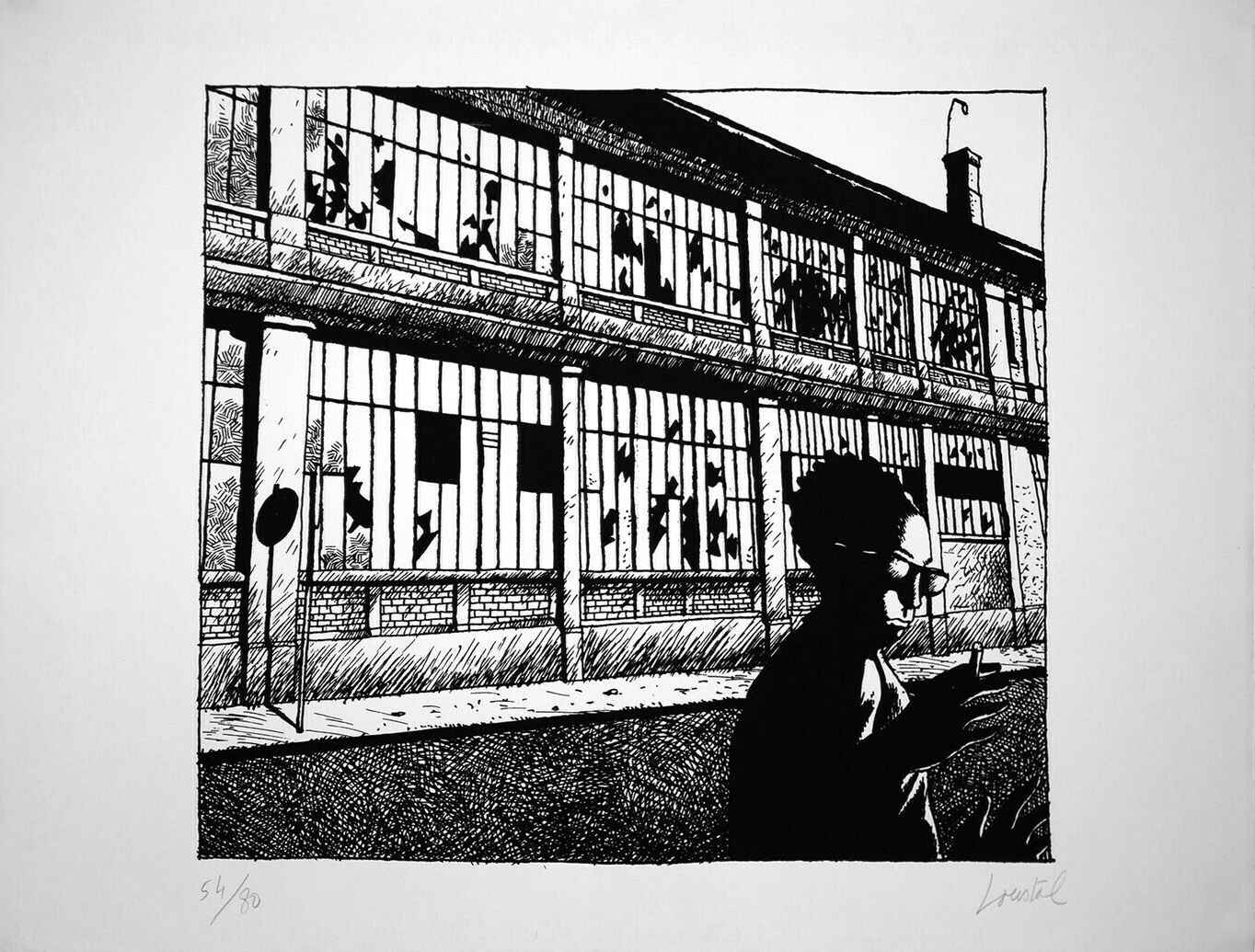
Artist
Title
Year
Technique
Size
Edition
Signed
Paper
Publisher
Jacques de Loustal
Usine
1981
Silkscreen print
65x50 cm
54/80
Yes
Dessin JA Arches France
Jacques Loustal
Jacques de Loustal
1956 -
A very rare monochromatic effort by Jacques Loustal. 'Usine' is one of a series 3 silkscreen prints issued by Loustal to mark the release of his 1980 album 'New York - Miami'. The series (consisting of the prints 'Briquet', 'Usine' and 'Cigarette') is personally handprinted by Loustal himself, and denotes his very first endeavour into silkscreen printing.
This is one of three limited edition prints published in April 1981 by Jacques Loustal, to mark the release of his first graphic novel.
The print depicts a character in front of an abandoned factory, and carries the caption "Majid aimait bien le bruit de l'atelier d'étirage - dommage que l'usine soit fermée."
MORRIS - Alerte aux pieds bleus

Artist
Title
Year
Technique
Size
Edition
Signed
Paper
Publisher
Morris
Alerte aux pieds bleus
2001
Silkscreen print
50x80 cm
5/199
Yes
Steinbach 300g
Champaka - Bruxelles

Morris (Maurice de Bevere)
1923 - 2001
Morris was a Belgian cartoonist, comics artist, illustrator and the creator of Lucky Luke, a bestselling comic series about a gunslinger in the American Wild West. Lucky Luke is the best-selling European comics series ever, with more than 300 million copies sold, and published in more than thirty languages. Morris collaborated for two decades with French writer René Goscinny on the series. Morris' pen name is an Anglicised version of his first name.
Despite his drawing style lending itself perfectly to the medium, the 'Alerte aux pieds bleus' print is one of Morris few forrays into silkscreen printing.
Issued by Champaka on November 1st 2000, this limited edition print is from the last print series ever signed by Morris. Originally intended as part of a diptych consisting of 'Alerte aux pieds bleus' and 'Ruée sur l'Oklahoma', the project was interrupted by Morris' death in 2001.
MANARA - Le Bain de Minuit
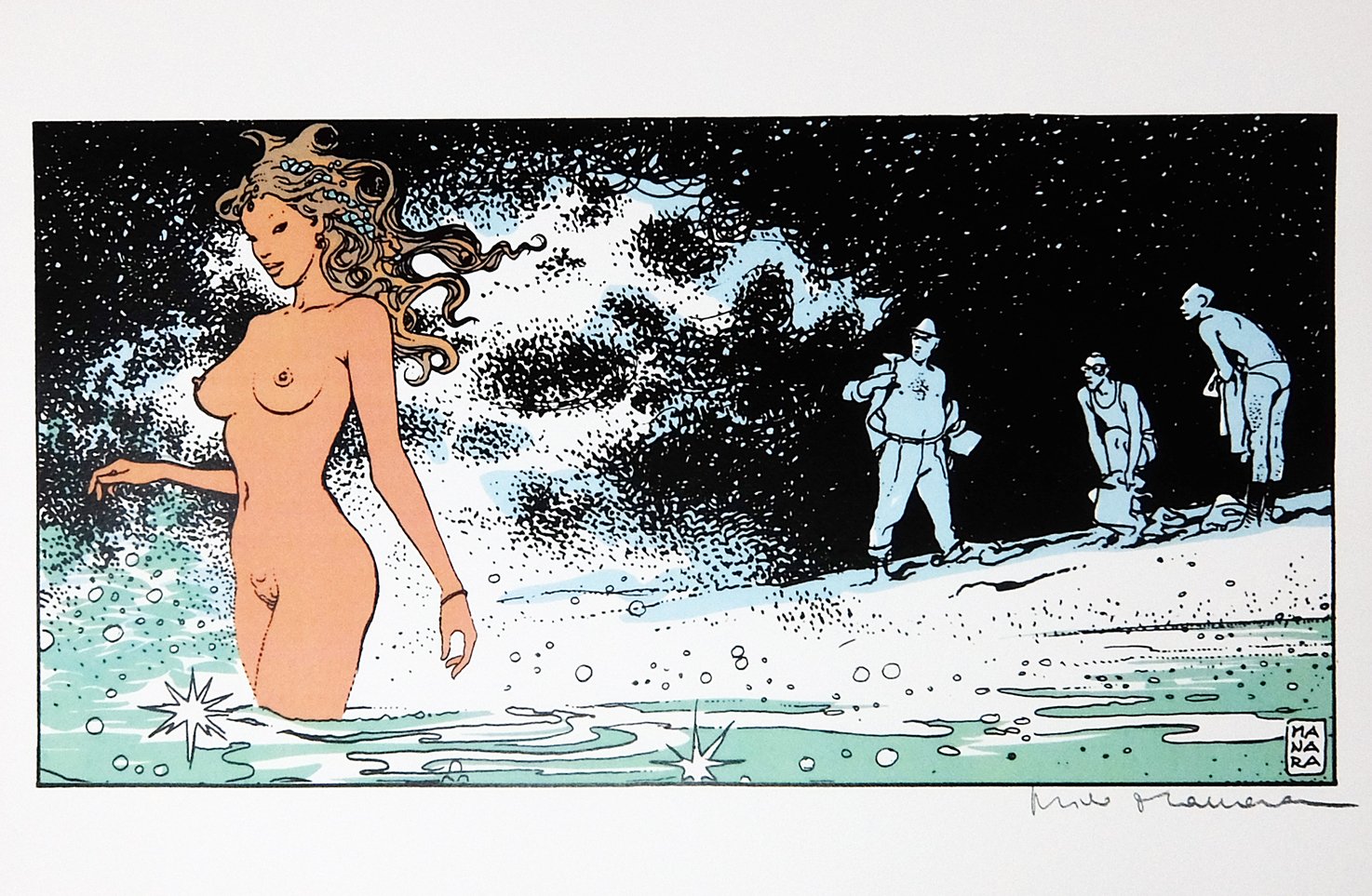
Artist
Title
Year
Technique
Size
Signed
Paper
Publisher
Milo Manara
Le Bain de Minuit
1998
Silkscreen print
32x45 cm
Yes
Steinbach
Editori del Grifo -
Montepulciano

Milo Manara
1945 -
Milo Manara, is an Italian comic book writer and artist. Manara is best known for producing comics that revolve around women caught up in unlikely and fantastical erotic scenarios, expressed in works such as Click (1983), about a device which renders women helplessly aroused. Manara also created the surreal 'HP and Giuseppe Bergman' trilogy. The character 'HP' is based on the Italian comics creator Hugo Pratt, with whom Manara later concocted the double album 'Indian Summer'.
This is an unnumbered print from Editori del Grifo.
The print depicts a frame from Fellini and Manara's 'Trip to Tulum'.
'Viaggio a Tulun' was originally intended by Fellini as a film adaptation of Carlos Castaneda's 'The Teachings of Don Juan'. But when Castaneda mysteriously disappeared during preproduction, leaving Fellini and crew stranded in the jungles of Mexico, the project was abandoned. Fellini instead enlisted the services of Manara and turned the screenplay into a comic book.
PRADO - Mujer con Caracol
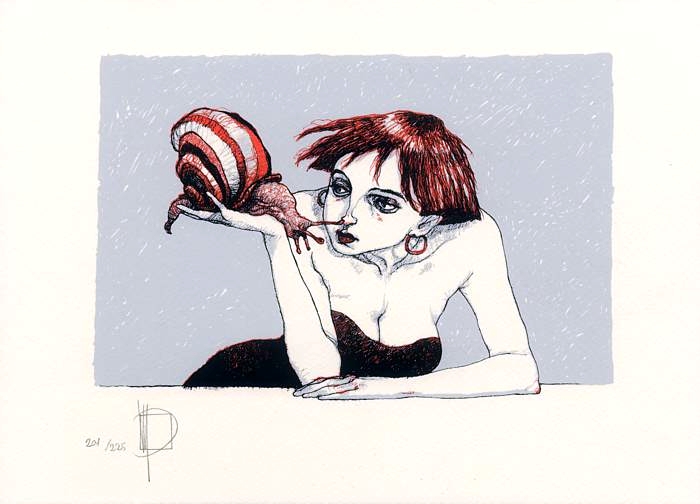
Artist
Title
Year
Technique
Size
Edition
Signed
Publisher
Miguelanxo Prado
Mujer con Caracol
2016
Silkscreen print
29,7x21 cm
206/225
Yes
Miguelanxo Prado
Miguelanxo Prado
1958 -
Miguelanxo Prado is a Galician comic book creator. Prado studied architecture, wrote novels and painted before his career in comics. His early works include the delirious and absurd: 'Chienne de Vie', 'C'est du Sport' and 'Y'a Plus de Justice'. His best-known comic book is Trazo de Tiza (Streak of Chalk): A dream-like, experimental story about a man on an island, unable to distinguish dream from reality, or present from past.
This limited edition print from late 2016 consists of three colour passages. Unlike most artists who delegate their works to professional printers, Miguelanxo Prado personally tends to every step of the printing process himself, from making the printing plates, to administering the dyes.
HERGÉ - Les Cigares du pharaon
Artist
Title
Year
Technique
Size
Signed
Publisher
Hergé
Les Cigares du pharaon
1986
Offset print
30x40 cm
No
Casterman

Hergé (Georges Remi)
1907 - 1983
Hergé was a Belgian comics writer and artist. His best known and most substantial work is the iconic 'The Adventures of Tintin' comic book series, which he wrote and illustrated from 1929 until his death in 1983. 'The Adventures of Tintin' which relays the story of a young Belgian reporter who travels the world with his dog Snowy to solve crime, is considered one of the most popular European comics of the 20th century. Today, Tintin has been published in more than 70 languages with sales of more than 200 million copies, and has been adapted into movies, television, and radio, solidifying Hergé’s status as one of the leading cartoonists of the 20th century. Hergé's work remains a strong influence on comics, particularly in Europe, due to his creation and pioneering of the 'Ligne claire' drawing style.
This is an offset poster from the 1986 Tintin Poster Book published by Casterman. The book contains a total of 21 posters, all full page drawings from Tintin books. For the purpose of the poster book some of the drawings were recoloured.
This full page drawing was first published in the 1938 version of the album 'Les Cigares du Pharaon'.
It depicts Tintin and Snowy in the desert.
UDERZO - Teleferic
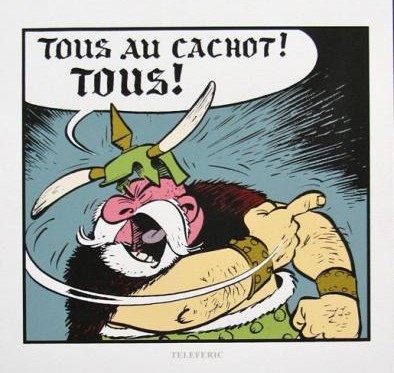
Artist
Title
Year
Technique
Size
Edition
Signed
Publisher
Albert Uderzo
Teleferic
1991
Silkscreen print
23x23 cm
X/250
No
Christian Desbois éditions - Rennes

Albert Uderzo
1927 - 2020
Albert Uderzo was a French comic book artist and scriptwriter. He is best known as the co-creator and illustrator of the Astérix series in collaboration with René Goscinny. Asterix is one of the most popular Franco-Belgian comics in the world, with the series being translated into 111 languages and dialects. After Goscinny's death in 1977, Uderzo continued to write and illustrate the books on his own. Other collaborations include 'Oumpah-pah' (also with Goscinny), and the aviation series 'Les Aventures de Tanguy et Laverdure' with Jean-Michel Charlier. .
This print is taken from the 1991 'Les Chefs' portfolio. The portfolio was issued in 250 copies and contains 11 smaller prints of individual chieftains from the Asterix series + one bigger print of chief Vitalstatistix and the village tribe. Only one print in each portfolio is numbered and signed (usually Redbeard the pirate captain).
This print depicts Chief Teleferic from the 1961 Asterix album 'Asterix and the Goths'
LOISEL - Le Chat
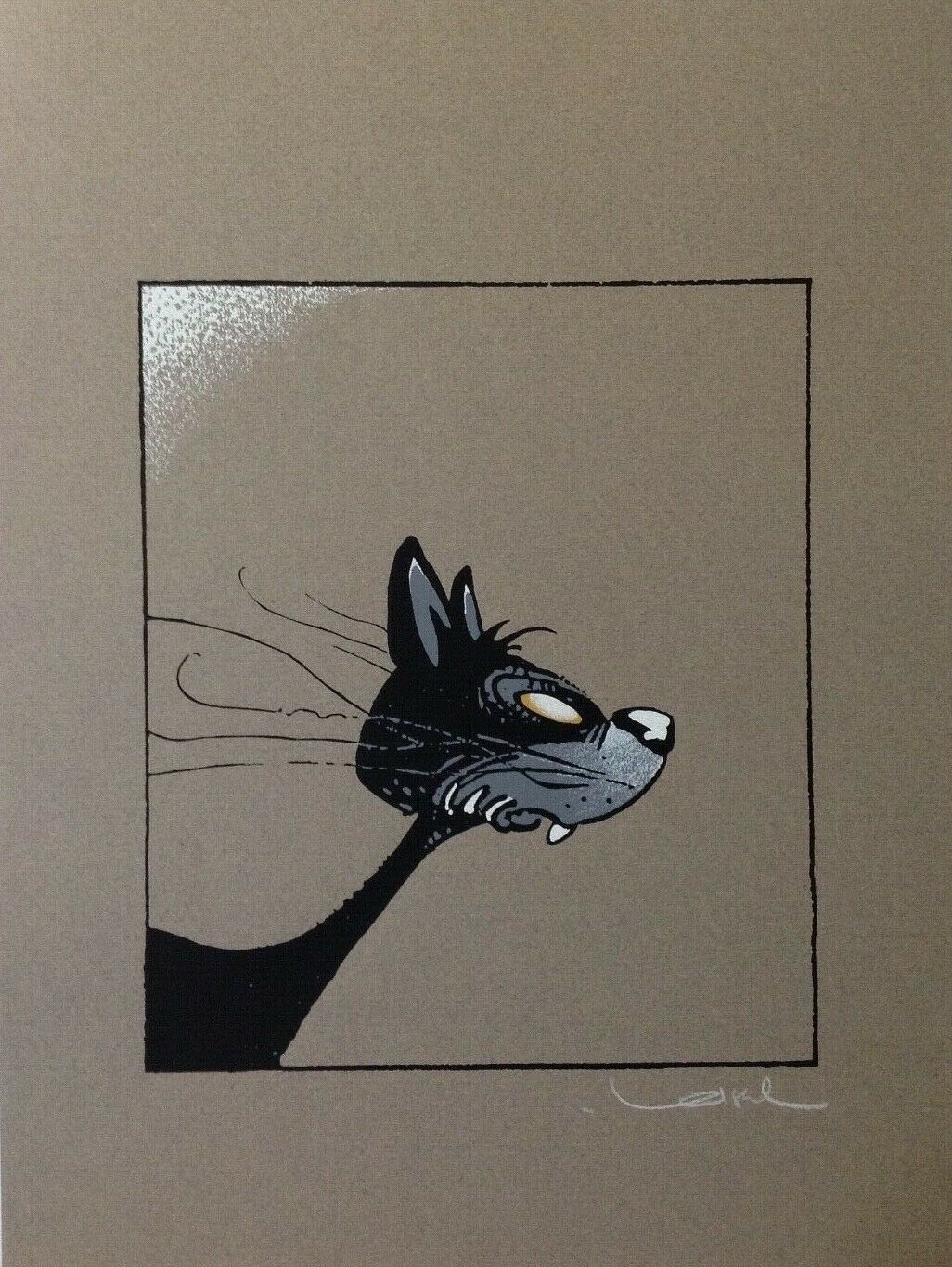
Artist
Title
Year
Technique
Size
Signed
Paper
Publisher
Régis Loisel
Le Chat
1985
Silkscreen print
30x40 cm
Yes
Papier Canson gris 250g
Granit Associés - Rennes

Régis Loisel
1951 -
Régis Loisel is a French cartoonist, best known for the series La Quête de l'oiseau du temps, written by Serge Le Tendre. He worked with Walt Disney Studios on the animated films Atlantis and Mulan.
This limited edition screenpint depicts a frame from a 1980 newspaper strip.
LIBERATORE - RanXerox Amen
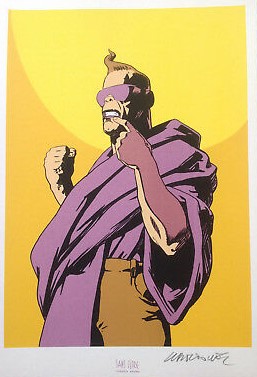
Artist
Title
Technique
Size
Edition
Signed
Publisher
Tanino Liberatore
RanXerox Amen
Silkscreen print
20x29 cm
114/225
Yes
Librarie Sans Titre, Paris
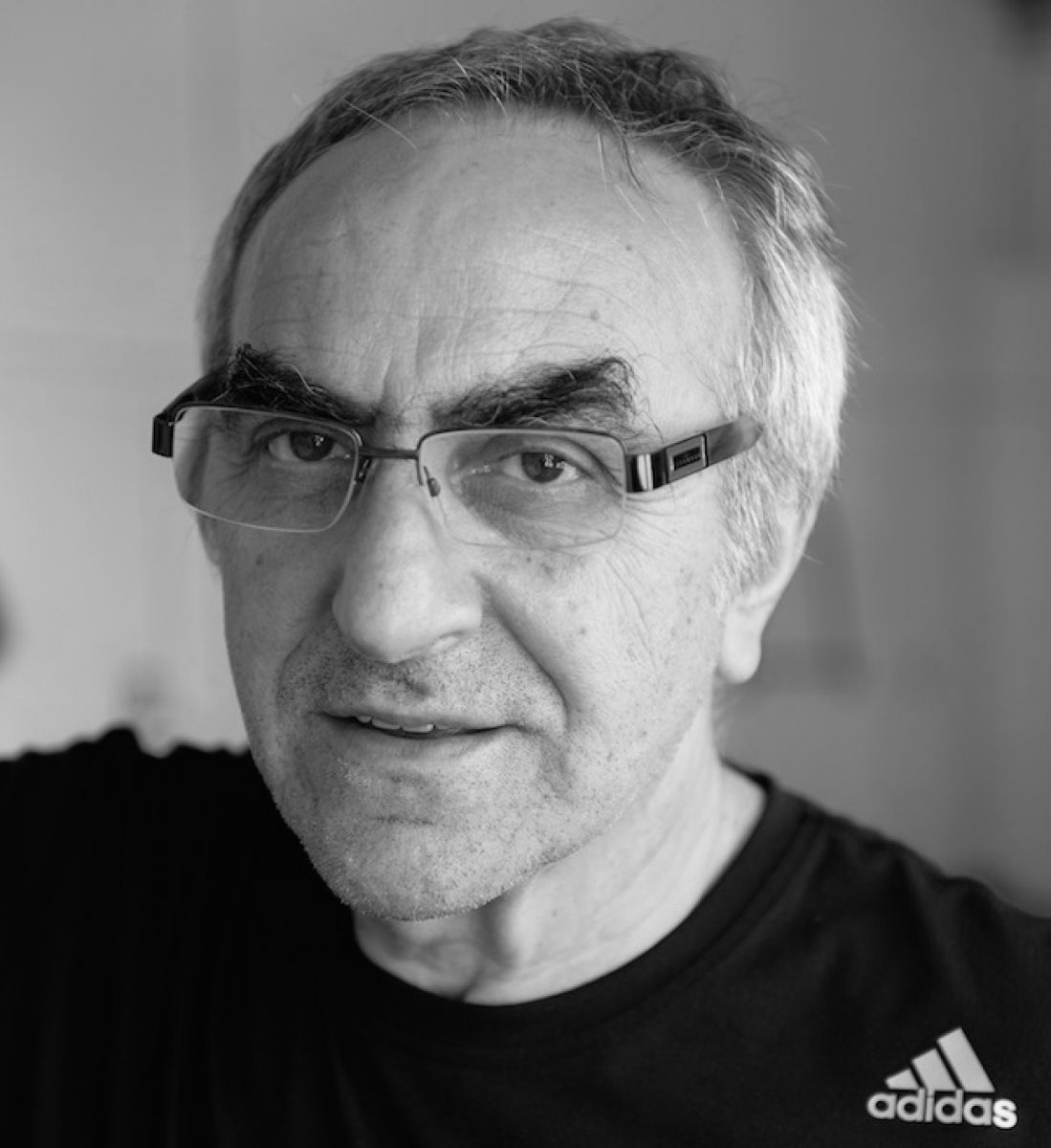
Tanino Liberatore
1953 -
Tanino Liberatore, is an Italian comics author and illustrator. His best known fictional character is RanXerox. Together with Stefano Tamburini he created 'Rank Xerox'; the not very bright, ultra violent cyborg. Several stand alone albums ensued, translated into several languages, until Tamburini's death in 1986 from a heroin overdose. The cover of Frank Zappa's The Man from Utopia album features an illustration by Tanino Liberatore, showing Zappa as RanXerox. He has additionally done art direction for films.
This is a limited edition Ex Libris print from Librarie Sans Titre depicting a frame from the 1996 album 'RanXerox Amen!'
LIDWINE - Historie de Pipes
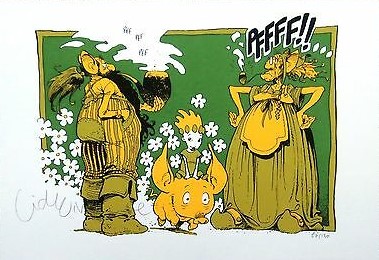
Artist
Title
Year
Technique
Size
Edition
Signed
Dominique Lidwine
Historie de Pipes
1998
Silkscreen print
13x19 cm
Ex Libris IX/LI
Yes
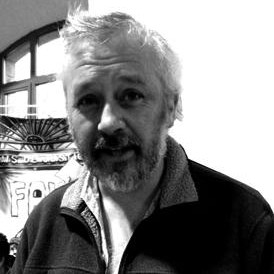
Dominique Lidwine
1960 -
Dominique Legeard - Lidwine is a French comic book artist. Lidwine was a contributor to Métal Hurlant from the age of 19, He also worked with Régis Loisel and Serge Le Tendre on 'Quête de l'Oiseau du Temps'.
This print is a limited edition Ex Libris. Ex Libris prints are small sized affordable prints.
REEDY - Godzilla in Japan
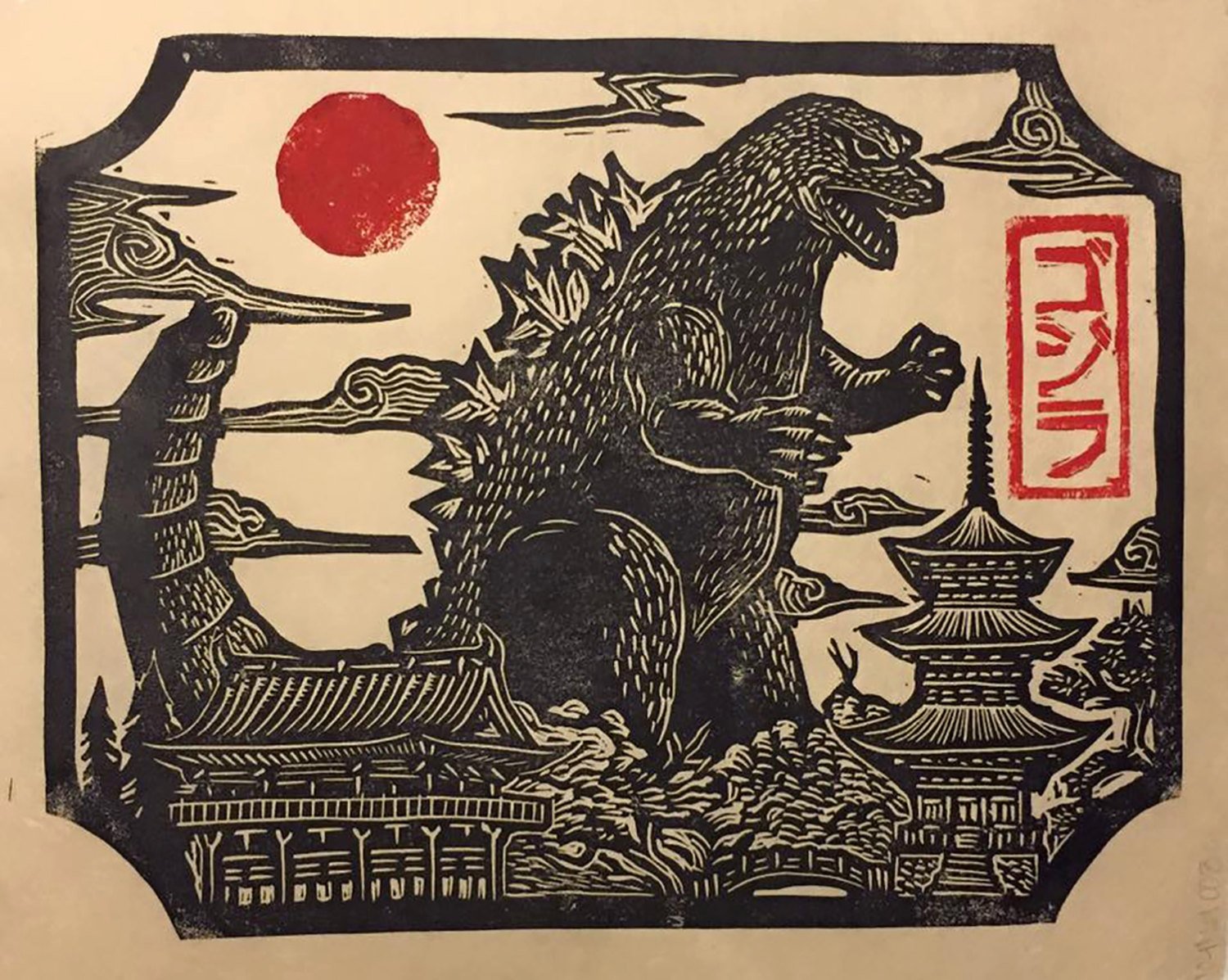
Artist
Title
Year
Technique
Size
Signed
Paper
Brian Reedy
Godzilla in Japan
2016
Linocut print
25x20 cm
Yes
Handmade rice paper
Brian Reedy
1970 -

Miami based Art teacher Reedy is known for his creative woodblock and linocut renderings of super heroes and other pop culture references. Some examples of his work touch on apocalyptic dystopian futures, mythic creatures and the gods and goddesses of Hinduism.
This print is an unlimited edition 2 colour passage linocut print on handmade ricepaper.
The print depicts Godzilla in a conventional Japanese landscape setting, thus mixing contemporary pop culture with Japanese woodblock tradition to amusing anachronistic effect.
HOGARTH - Marriage a la mode plate VI
Artist
Title
Year
Technique
Size
Publisher
William Hogarth
Marriage a la mode plate VI
1890
Copper engraving
13x19 cm
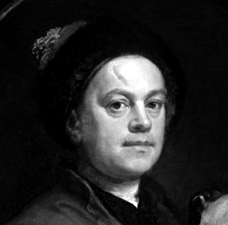
William Hogarth
1697 - 1764

William Hogarth was an English painter, printmaker, pictorial satirist, social critic, and editorial cartoonist. He is perhaps best known for his series A Harlot's Progress, A Rake's Progress and Marriage A-la-Mode. Knowledge of his work is so pervasive that satirical political illustrations in this style are often referred to as "Hogarthian". Influenced by French and Italian painting and engraving, Hogarth's works are mostly satirical caricatures, sometimes bawdily sexual, mostly of the first rank of realistic portraiture. They became widely popular and mass-produced via prints in his lifetime, and he was by far the most significant English artist of his generation.
This is the 1890 edition of the sixth plate of Hogart's Marriage A-la-Mode series; a series of six engraved copper plate prints, intended as a pointed skewering of 18th-century society. They show the disastrous results of an ill-considered marriage for money and social status.
This print depicts the sad aftermath after the grief and poverty-stricken countess has poisoned herself. On the floor lies the used bottle of Laudanum, along with the newsletter announcing that her lover has been hanged for murdering her husband. The mark on the daughter's cheek and the caliper on her leg suggest that her parents' syphilis has been passed onto the next generation. The dimwitted servant who has procured the Laudanum is being berated, while the countess's miserly father, removes the wedding ring, the only valuable possession his late daughter has left, from her finger.
HOGARTH - The Reward of Cruelty
Artist
Title
Year
Technique
Size
Publisher
William Hogarth
The Four stages of Cruelty. Plate IV:
The Reward of Cruelty
1840
Steel engraving
13x19 cm
London Printing and Publishing Company

William Hogarth
1697 - 1764

William Hogarth was an English painter, printmaker, and social critic. His work ranged from realistic portraiture to comic strip-like series of pictures called "modern moral subjects". Hogarth was born in London to a poor middle-class family. In his youth he took up an apprenticeship where he specialised in engraving. His father underwent periods of mixed fortune, and was at one time imprisoned in lieu of outstanding debts; an event that is thought to have informed William's paintings and prints with a hard edge.
This print is the 1840 edition of the fourth plate of Hogart's 'The Four Stages of Cruelty' series; a series of four printed engravings originally published in 1751. Each print depicts a different stage in the life of the fictional Tom Nero, progressing from animal cruelty through murder to execution and dissection.
Plate IV depicts the public dissection of the recently executed Tom Nero. The rope still around his neck shows his method of execution. The dissectors are shown to have as much feeling for the body as Nero had for his victims; his eye is put out just as his horse's was, and a dog feeds on his heart, taking a poetic revenge for the torture inflicted on one of its kind in the first plate. Just as his murdered mistress's finger pointed to Nero's destiny in plate III 'Cruelty in Perfection', in this print Nero's finger points to the boiled bones being prepared for display, indicating his ultimate fate.
DORÉ - Inferno, Canto X, Farinata degli Uberti addresses Dante
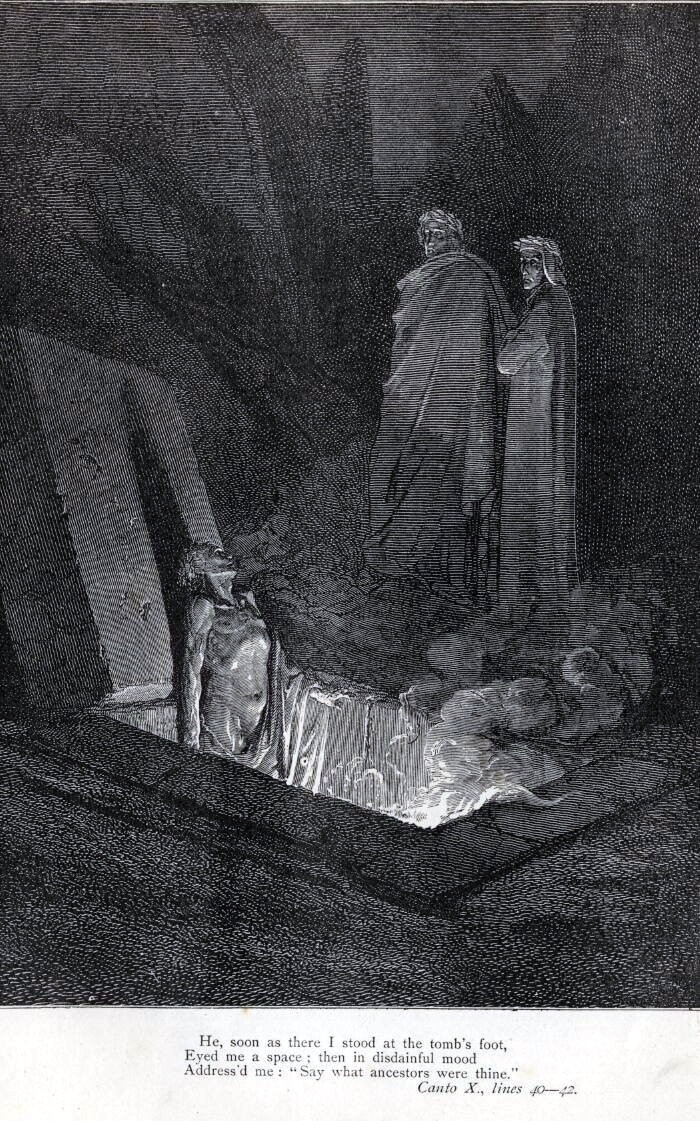
Artist
Title
Year
Technique
Size
Publisher
Gustave Doré
Canto X, Farinata degli Uberti addresses Dante
1860
Modified wood engraving
13x19 cm
Henry G. Bohn, London
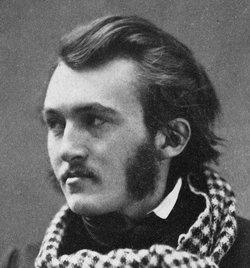
Gustave Doré
1832 - 1883
Gustave Doré was a prolific engraver, artist, illustrator, and sculptor, working primarily as a wood and steel engraver. He produced over 100,000 sketches in his lifetime. His works are considered some of the most important in the entire engraving art world. As an illustrator, Dore created engravings for the books of Balzac, Rabelais, Jules Verne, Dante, Edgar Allen Poe, and Lord Byron.
This print is cut out engraving from the 1860 English version of Dante's 'Inferno'.
The print depicts Dante and Virgil in the Sixth circle of Hell, in front of the open tomb of Florentine aristocrat and military leader Farinata degli Uberti. Even as he spends eternity suffering in hell, the local feuds between families and political factions in Florence are still a matter of concern for Farinata. Recognising Dante as a fellow Florentine, he seeks to ascertain what family Dante belongs to.
WHYMPER - The Colosseum
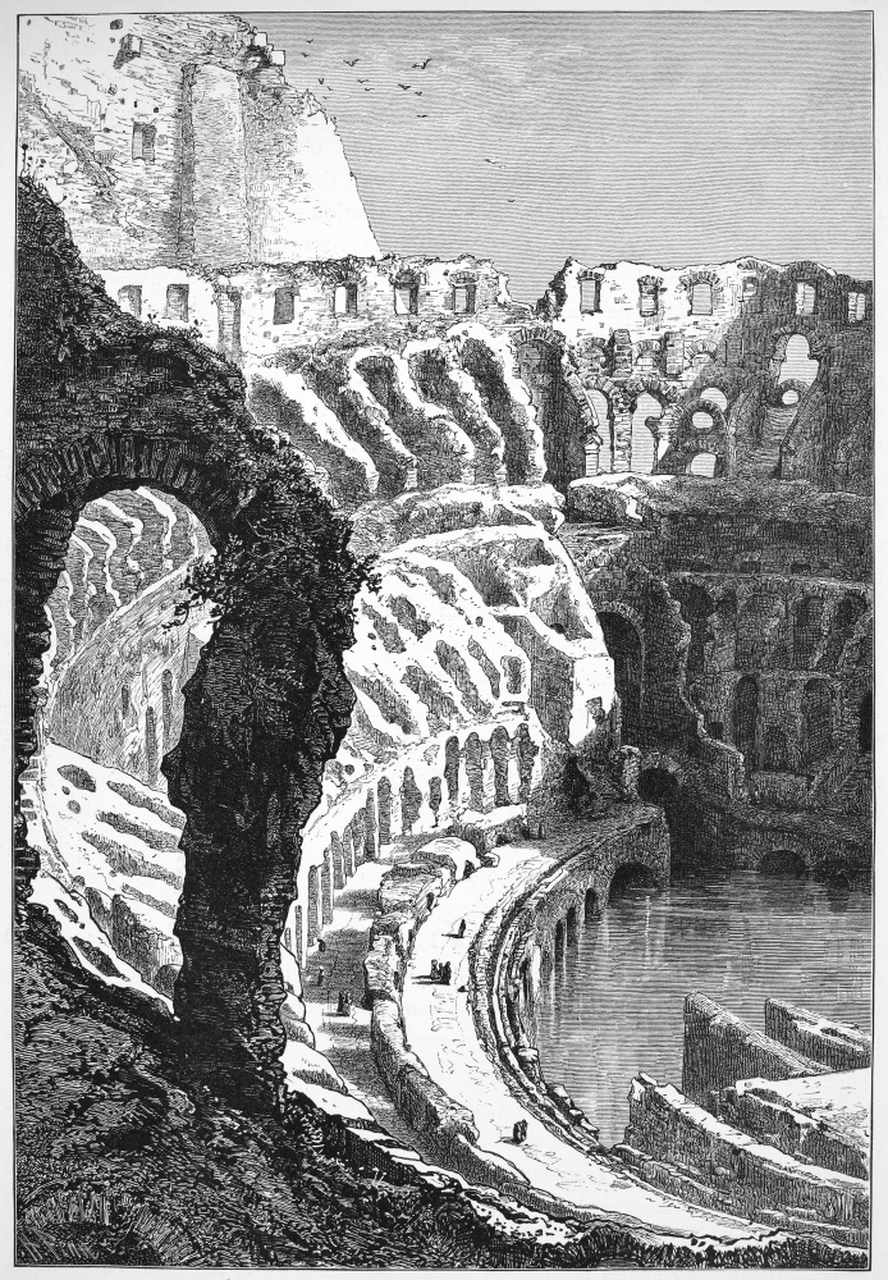
Artist
Title
Year
Technique
Size
Publisher
Josiah Wood Whymper
The Colosseum
1878
Wood engraving
13x19 cm
Cassell & Co. London
Josiah Wood Whymper
1813 - 1903

Josiah Wood Whymper was a British wood-engraver, book illustrator and watercolourist. He was expert at illustrating nature, such as dramatic engravings of natural phenomena such as aurora borealis, rainbows, icebergs, volcanoes and the mysterious Fata Morgana. His engravings for 'British Birds in Their Haunts' is widely regarded as his finest work. He additionally provided engravings for books about travel and expeditions such as 'The Naturalist on the River Amazons', 'the Life and Habits of Wild Animals', 'Himalayan Journals' and David Livingstone's 'Narrative of an Expedition to the Zambesi'.
This print is cut out engraving from volume 3 of Cassell & Co's 'Pictoresque Europe' series of which Whymper curated the illustrations. The engraving is performed by Whymper after a sketch by Harry Fenn.
The print depicts a South/East facing view of the interior of the Colosseum in Rome. From a historic perspective the illustration is interesting, as it shows the excavations of the Hypogeum, commenced in 1874, and the consequent groundwater floodings. Additionally the print also reveals the state of the Maenianum (or tiers) prior to the heavy handed concrete capping restorations of the 1910s.